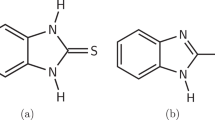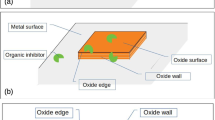Abstract
A CHEMICAL process in which one of the reacting substances and also the product of the reaction are solid has one feature not shown when the product is gaseous or liquid; the product must necessarily form a barrier between the reacting substances, so that the reaction can only proceed either if the product is continually removed, or if the reacting substances can penetrate the barrier. In the oxidation of metals the rate of the reaction is almost entirely controlled by the rate at which metal or oxygen can penetrate the oxide layer. In general, as the oxide layer becomes thicker, the rate of reaction becomes slower. In some metals, notably aluminium, chromium and probably zinc below 225° C, oxidation stops altogether when the film has reached a thickness of the order of 10″6 cm., the protective film thus formed preventing further attack. The discussion of these protective films will be one of the chief purposes of this article
This is a preview of subscription content, access via your institution
Access options
Subscribe to this journal
Receive 51 print issues and online access
$199.00 per year
only $3.90 per issue
Buy this article
- Purchase on Springer Link
- Instant access to full article PDF
Prices may be subject to local taxes which are calculated during checkout
Similar content being viewed by others
References
Vernon, W. H. J., Akeroyd, E. I., and Stroud, E. G., J. Inst. Metals, 65, 301 (1940).
Appleyard, E. T. S., and Bristow, J. R., Proc. Roy. Soc., A, 172, 530 (1939).
Lovell, A. C. B., Proc. Roy. Soc., A, 157, 311 (1936); 166, 270 (1938).
Mott, N. F., Trans. Far. Soc., 36, 1 (1940); J. Inst. Metals, 65, 301 (1940) (Discussion remark).
Vernon, W. H. J., Trans. Far. Soc., 31, 1670 (1935).
Wagner, C., Z. phys. Chem., B, 32, 459 (1933).
Tammann, G., Z. anorg. Chemie, 111, 78 (1920).
Pilling, N. B., and Bedworth, R. E., J. Inst. Metals, 29, 529 (1923).
Wagner, C., and Grünewald, K., Z. phys. Chem., B, 40, 455 (1938).
Wagner, C., Z. phys. Chem., B, 21, 25 (1933).
See, for example, Mott, N. F., and Gurney, R. W., “Electronic Processes in Ionic Crystals” (Oxford, 1940).
Erbacher, Z. phys. Chem., 63, 215 (1933).
Steinheil, Ann. Phys., 19, 465 (1934).
Quoted by Evans, “Metallic Corrosion”, p. 76 (London, 1937).
Thomson and Cochrane, “Theory and Practice of Electron Diffraction”, chapter xii (Macmillan, 1939).
Mott, N. F., Trans. Far. Soc., 35, 1179 (1939); 36, 472 (1940).
Sutton and Willstrop, J. Inst. Metals, 38, 259 (1928).
Friederich, E., Z. Phys., 31, 813 (1925); Blanc, M. le, and Sachse, H., Phys. Z., 32, 887 (1931); Wagner, C., Z. phys. Chem., B., 22, 181 (1933).
Mott, N. F., Trans. Far. Soc., 34, 500 (1938).
Portevin, Pretet and Jolivet, J. Iron Steel Inst., 130, 219 (1934).
Fröhlich, K. W., Z. Metallkunde, 28, 368 (1936).
Iitaka and Miyake, NATURE, 137, 457 (1936).
Author information
Authors and Affiliations
Rights and permissions
About this article
Cite this article
MOTT, N. Oxidation of Metals and the Formation of Protective Films. Nature 145, 996–1000 (1940). https://doi.org/10.1038/145996a0
Issue Date:
DOI: https://doi.org/10.1038/145996a0
This article is cited by
-
Chemo-mechanical coupling effect on high temperature oxidation: A review
Science China Technological Sciences (2019)
Comments
By submitting a comment you agree to abide by our Terms and Community Guidelines. If you find something abusive or that does not comply with our terms or guidelines please flag it as inappropriate.



